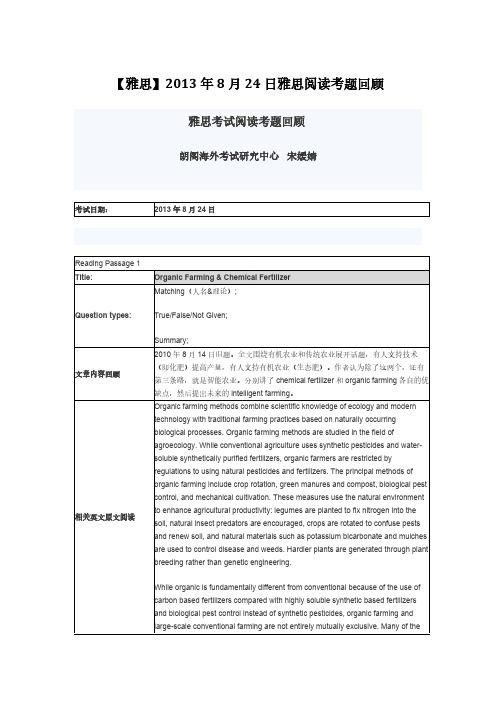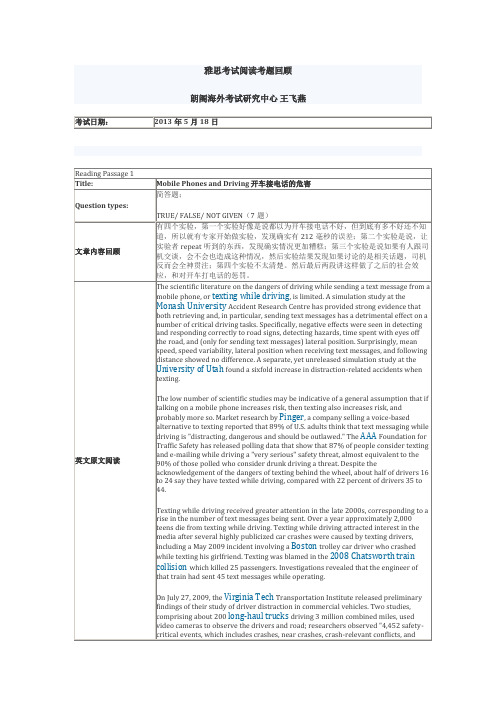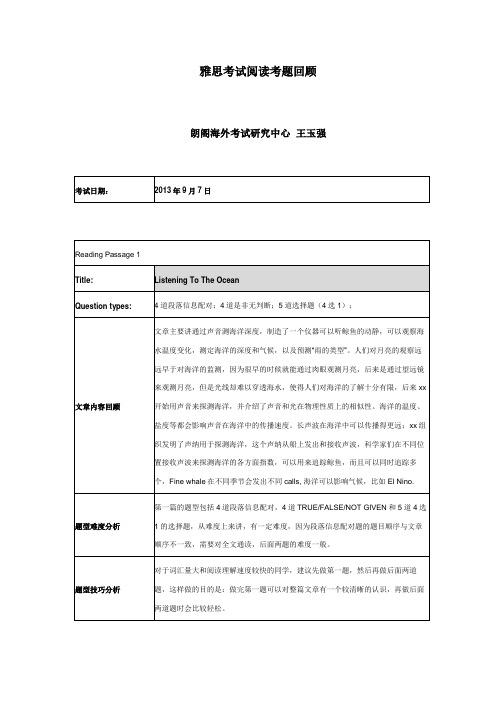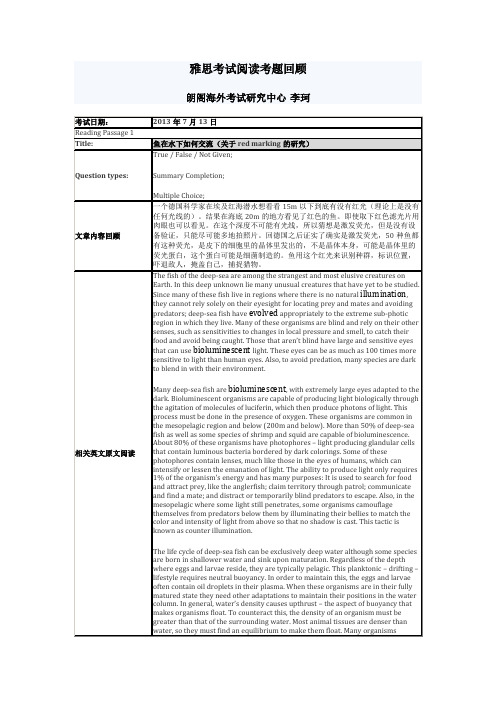【雅思】北京朗阁2013年7月27日雅思阅读考题回顾
- 格式:docx
- 大小:24.79 KB
- 文档页数:6

【雅思】2013年8月24日雅思阅读考题回顾雅思考试阅读考题回顾朗阁海外考试研究中心宋媛婧考试日期:2013年8月24日methods developed for organic agriculture have been borrowed by more conventional agriculture. For example, Integrated Pest Management is a multifaceted strategy that uses various organic methods of pest control whenever possible, but in conventional farming could include synthetic pesticides only as a last resort.Crop diversityCrop diversity is a distinctive characteristic of organic farming. Conventional farming focuses on mass production of one crop in one location, a practice called monoculture. The science of agroecology has revealed the benefits of polyculture (multiple crops in the same space), which is often employed in organic farming. Planting a variety of vegetable crops supports a wider range of beneficial insects, soil microorganisms, and other factors that add up to overall farm health. Crop diversity helps environments thrive and protect species from going extinct.Soil managementOrganic farming relies heavily on the natural breakdown of organic matter, using techniques like green manure and composting, to replace nutrients taken from the soil by previous crops. This biological process, driven by microorganisms such as mycorrhiza, allows the natural production of nutrients in the soil throughout the growing season, and has been referred to as feeding the soil to feed the plant. Organic farming uses a variety of methods to improve soil fertility, including crop rotation, cover cropping, reduced tillage, and application of compost. By reducing tillage, soil is not inverted and exposed to air; less carbon is lost to the atmosphere resulting in more soil organic carbon. This has an added benefit of carbon sequestration which can reduce green house gases and aid in reversing climate change.Plants need nitrogen, phosphorus, and potassium, as well as micronutrients and symbiotic relationships with fungi and other organisms to flourish, but getting enough nitrogen, and particularly synchronization so that plants get enough nitrogen at the right time (when plants need it most), is a challenge for organic farmers. Crop rotation and green manure ("cover crops") help to provide nitrogen through legumes (more precisely, the Fabaceae family) which fix nitrogen from the atmosphere through symbiosis with rhizobial bacteria. Intercropping, which is sometimes used for insect and disease control, can also increase soil nutrients, but the competition between the legume and the crop can be problematic and wider spacing between crop rows is required. Crop residues can be ploughed back into the soil, and different plants leave different amounts of nitrogen, potentially aiding synchronization. Organic farmers also use animal manure, certain processed fertilizers such as seed meal and various mineral powders such as rock phosphate and greensand, a naturally occurring form of potash which provides potassium. Together these methods help to control erosion. In some cases pHmay need to be amended. Natural pH amendments include lime and sulfur, but in the U.S. some compounds such as iron sulfate, aluminum sulfate, magnesium sulfate, and soluble boron products are allowed in organic farming.Mixed farms with both livestock and crops can operate as ley farms, whereby the land gathers fertility through growing nitrogen-fixing forage grasses such as white clover or alfalfa and grows cash crops or cereals when fertility is established. Farms without livestock ("stockless") may find it more difficult to maintain soil fertility, and may rely more on external inputs such as imported manure as well as grain legumes and green manures, although grain legumes may fix limited nitrogen because they are harvested. Horticultural farms growing fruits and vegetables which operate in protected conditions are often even more reliant upon external inputs.Biological research on soil and soil organisms has proven beneficial to organic farming. Varieties of bacteria and fungi break down chemicals, plant matter and animal waste into productive soil nutrients. In turn, they produce benefits of healthier yields and more productive soil for future crops. Fields with less or no manure display significantly lower yields, due to decreased soil microbe community, providing a healthier, more arable soil system.题型难度分析人名观点Matching题属于简单题型,定位非常容易。





2013年4月18日雅思阅读考试回忆刘美超老师简介:环球雅思教研主管。
中国石油大学英语专业科班出身,持有专业英语八级证书、教师资格证书。
“三维一体”听力教学,集场景教学、做题技巧与应试策略于一体;授课亲切自然,实力与技巧完美结合。
深谙雅思各级学员状况,量体裁衣,为学生提供无间隙性服务!使用说明:本文系环球雅思教研主管刘美超老师征集,环球雅思学校赵晨老师撰写的原创文章。
赵晨老师主讲雅思阅读,写作,英语翻译硕士,专业八级,专业笔译口译。
完整版回忆可直接去环球雅思论坛进行下载。
阅读: 2篇旧题第一篇:斯里兰卡水箱Q1-6: Summary 填空题 ( NO MORE THAN THREE WORDS)1. What is the major way for local people make b arely a support of living in Muthukandiya village?Crop production B段第三行2. Where can adult workers make extra money from in daytime?Sugar-cane plantations3. What have been dug to supply water for daily household life?Three wells4. In which year did the plan of a new project to lessen the effect ofdrought begin?19985. Where do the gutters and pipes collect rainwater from?roofs of houses6. What help family obtain more water for domestic needs than those relying on only wells and ponds?Storage tanksQ7-14: YES/NO/NOT GIVEN7. NGMost of the government’s actions and other programs have somewhat f ailed.8. YESMasons w ere trained for the constructing parts of the rainwater harvesting system.9. NOThe cost of rainwater harvesting systems was shared by local villagersand the local government.10. YESTanks increase both the amount and quality of the water for domestic use.11. NOTo send her daughter to school, a widow had to work for a job in rainwater harvesting scheme.12. NOT GIVENHouseholds benefited began to pay part of the maintenance or repairs.13. NOT GIVENTraining two masons at the same time is much more preferable to training single one.14. NOOther organizations had built tanks larger in size than the tanks builtin Muthukandya.第二篇:化学发展史1-6: Information Containing:1. The development of various scientific methods D2. A reference of personal connection between different sciences B3. Explain the limitation of chemical equipment at that time D4. Applicable devices invented within chemistry E5. History of great leaping development of chemist F6. The unstable political situation of different countries A7-13: Summary:Chemistry rely on __________, just as ____rely on eyes, and _______need devices such as _________ in early chemistry, chemists used differentnumber of ________ to control temperature of the fires. Although _____was known in classic Greece and it seems to have been invented and made inVenice or northern Italy about 1289. _____________ was put in the thermometer which made chemistry further development.7. Tools8. Astronomy9. Burning glass10. Physics11. Candles12. Pendulum13. Alcohol/mercury thermometer环球雅思学校刘美超微博名:YS美超环球雅思学校教研中心微博名:环球雅思教研中心。
2013年7月13日雅思阅读考题回顾来源:朗阁培训中心编辑:xm 发布日期:2013-07-22 摘要:厦门朗阁培训中心为烤鸭们整理了7月13日雅思阅读考题回顾以及备考建议。
solely on their eyesight for locating prey and mates and avoiding predators; deep-sea fish have evolved appropriately to the extreme sub-photic region in which they live. Many of these organisms are blind and rely on their other senses, such as sensitivities to changes in local pressure and smell, to catch their food and avoid being caught. Those that aren’t blind have large and sensitive eyes that can use bioluminescent light. These eyes can be as much as 100 times more sensitive to light than human eyes. Also, to avoid predation, many species are dark to blend in with their environment.Many deep-sea fish are bioluminescent, with extremely large eyes adapted to the dark. Bioluminescent organisms are capable of producing light biologically through the agitation of molecules of luciferin, which then produce photons of light. This process must be done in the presence of oxygen. These organisms are common in the mesopelagic region and below (200m and below). More than 50% of deep-sea fish as well as some species of shrimp and squid are capable of bioluminescence. About 80% of these organisms have photophores – light producing glandular cells that contain luminous bacteria bordered by dark colorings. Some of these photophores contain lenses, much like those in the eyes of humans, which can intensify or lessen the emanation of light.The ability to produce light only requires 1% of the organism's energy and has many purposes: It is used to search for food and attract prey, like the anglerfish; claim territory through patrol; communicate and find a mate; and distract or temporarily blind predators to escape. Also, in the mesopelagic where some light still penetrates, some organisms camouflage themselves from predators below them by illuminating their bellies to match the color and intensity of light from above so that no shadow is cast. This tactic is known as counter illumination.The life cycle of deep-sea fish can be exclusively deep water although some species are born in shallower water and sink upon maturation. Regardless of the depth where eggs and larvae reside, they are typically pelagic. This planktonic – drifting – lifestyle requires neutral buoyancy. In order to maintain this, the eggs and larvae often contain oil droplets in their plasma. When these organisms are in their fully matured state they need other adaptations to maintain their positions in the water column. In general, water’s density causes upthrust – the aspect of buoyancy that makes organisms float. To counteract this, the density of an organism must be greater than that of the surrounding water. Most animal tissues are denser than water, so they must find an equilibrium to make them float. Many考试趋势分析和备考指导:本次考试四大题型一个不落集体出现,单选和完成句子选择作为非主流题型在2篇文章中都有所涉及,选择、判断、配对的数量以绝对的优势压倒了填空题,所以本次考试的难度系数较大。
雅思考试阅读考题回顾朗阁海外考试研究中心郑虹考试日期: 2015年10月10日Reading Passage 1Title: SeedHuntingQuestion types: 判断题6题摘要填空题5题多选题2题文章内容回顾大意是有一个群体,他们的职业就是收集种子,在全球各地行走,为生物科技公司或者药品公司收集植物的种子。
除了科研以外,还可以帮助我们保留正在濒危或者可能灭绝的植物。
因为这些努力,很多本应该灭绝的物种被保留了下来。
有个叫seed banks的地方专门用于安置植物种子,其负责人表示,在这些植物消失之前,能有人用行动拯救它们是非常可喜的。
但是很多这类seed banks也面临着资金短缺的问题。
题型难度分析1-6判断题1. The purpose of collecting seeds now is different from the past. TRUE2. The millennium seed bank is the earliest seed bank. NOT GIVEN3. One of major threats for plant species extinction is farmland expansion into wildness. TRUE4. The approach that scientists apply to store seeds is similar to that used by farmers. TRUE5. Technological development is the only hope to save plant species. FALSE6. The works of seed conservation are often limited by financial problems. TRUE7-11摘要填空题Some people collect seeds for the purpose of protecting certain species from 7. extinction; others collect seeds for their ability to produce 8. drugs/crops. They are called seed hunters. The 9. pioneers of them included both gardeners and botanists, such as 10. Sir Joseph Banks, who financially supported collectors out his own pocket. The seeds collected are usually stored in seed banks, one of which is the famous millennium seed bank, where seeds are all stored in the 11. underground vaults at a low temperature.12-13多选题Which Two of the following are provided by plants to the human?选:A & BA. foodB. fuelsC. clothesD. energyE. commercial products本篇文章的难度中等,第一个题型是判断题,判断题是雅思阅读必考题型,大家在备考的时候应该格外注意,判断题出题按顺序,不难定位到。